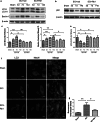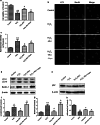Inhibition of Autophagy is Involved in the Protective Effects of Ginsenoside Rb1 on Spinal Cord Injury
- PMID: 28762191
- PMCID: PMC11481967
- DOI: 10.1007/s10571-017-0527-8
Inhibition of Autophagy is Involved in the Protective Effects of Ginsenoside Rb1 on Spinal Cord Injury
Abstract
Spinal cord injury (SCI) is a devastating neurological disorder. Autophagy is induced and plays a crucial role in SCI. Ginsenoside Rb1 (Rb1), one of the major active components extracted from Panax Ginseng CA Meyer, has exhibited neuroprotective effects in various neurodegenerative diseases. However, it remains unknown whether autophagy is involved in the neuroprotection of Rb1 on SCI. In this study, we examined the regulation of autophagy following Rb1 treatment and its involvement in the Rb1-induced neuroprotection in SCI and in vitro injury model. Firstly, we found that Rb1 treatment decreased the loss of motor neurons and promoted function recovery in the SCI model. Furthermore, we found that Rb1 treatment inhibited autophagy in neurons, and suppressed neuronal apoptosis and autophagic cell death in the SCI model. Finally, in the in vitro injury model, Rb1 treatment increased the viability of PC12 cells and suppressed apoptosis by inhibiting excessive autophagy, whereas stimulation of autophagy by rapamycin abolished the anti-apoptosis effect of Rb1. Taken together, these findings suggest that the inhibition of autophagy is involved in the neuroprotective effects of Rb1 on SCI.
Keywords: Apoptosis; Autophagy; Ginsenoside Rb1; Spinal cord injury.
Conflict of interest statement
The authors declare that there is no conflict of interest.
Figures






References
-
- Adhami F, Liao G, Morozov YM, Schloemer A, Schmithorst VJ, Lorenz JN, Dunn RS, Vorhees CV, Wills-Karp M, Degen JL, Davis RJ, Mizushima N, Rakic P, Dardzinski BJ, Holland SK, Sharp FR, Kuan CY (2006) Cerebral ischemia-hypoxia induces intravascular coagulation and autophagy. Am J Pathol 169(2):566–583. doi:10.2353/ajpath.2006.051066 - PMC - PubMed
-
- Bisicchia E, Latini L, Cavallucci V, Sasso V, Nicolin V, Molinari M, D’Amelio M, Viscomi MT (2016) Autophagy inhibition favors survival of rubrospinal neurons after spinal cord hemisection. Mol Neurobiol. doi:10.1007/s12035-016-0031-z - PubMed
-
- Bursch W, Ellinger A, Kienzl H, Torok L, Pandey S, Sikorska M, Walker R, Hermann RS (1996) Active cell death induced by the anti-estrogens tamoxifen and ICI 164 384 in human mammary carcinoma cells (MCF-7) in culture: the role of autophagy. Carcinogenesis 17(8):1595–1607 - PubMed
-
- Chen HC, Fong TH, Lee AW, Chiu WT (2012) Autophagy is activated in injured neurons and inhibited by methylprednisolone after experimental spinal cord injury. Spine 37(6):470–475. doi:10.1097/BRS.0b013e318221e859 - PubMed
-
- Chen B, Yue R, Yang Y, Zeng H, Chang W, Gao N, Yuan X, Zhang W, Shan L (2015) Protective effects of (E)-2-(1-hydroxyl-4-oxocyclohexyl) ethyl caffeine against hydrogen peroxide-induced injury in PC12 cells. Neurochem Res 40(3):531–541. doi:10.1007/s11064-014-1498-5 - PubMed
MeSH terms
Substances
Grants and funding
LinkOut - more resources
Full Text Sources
Other Literature Sources
Medical
Miscellaneous

